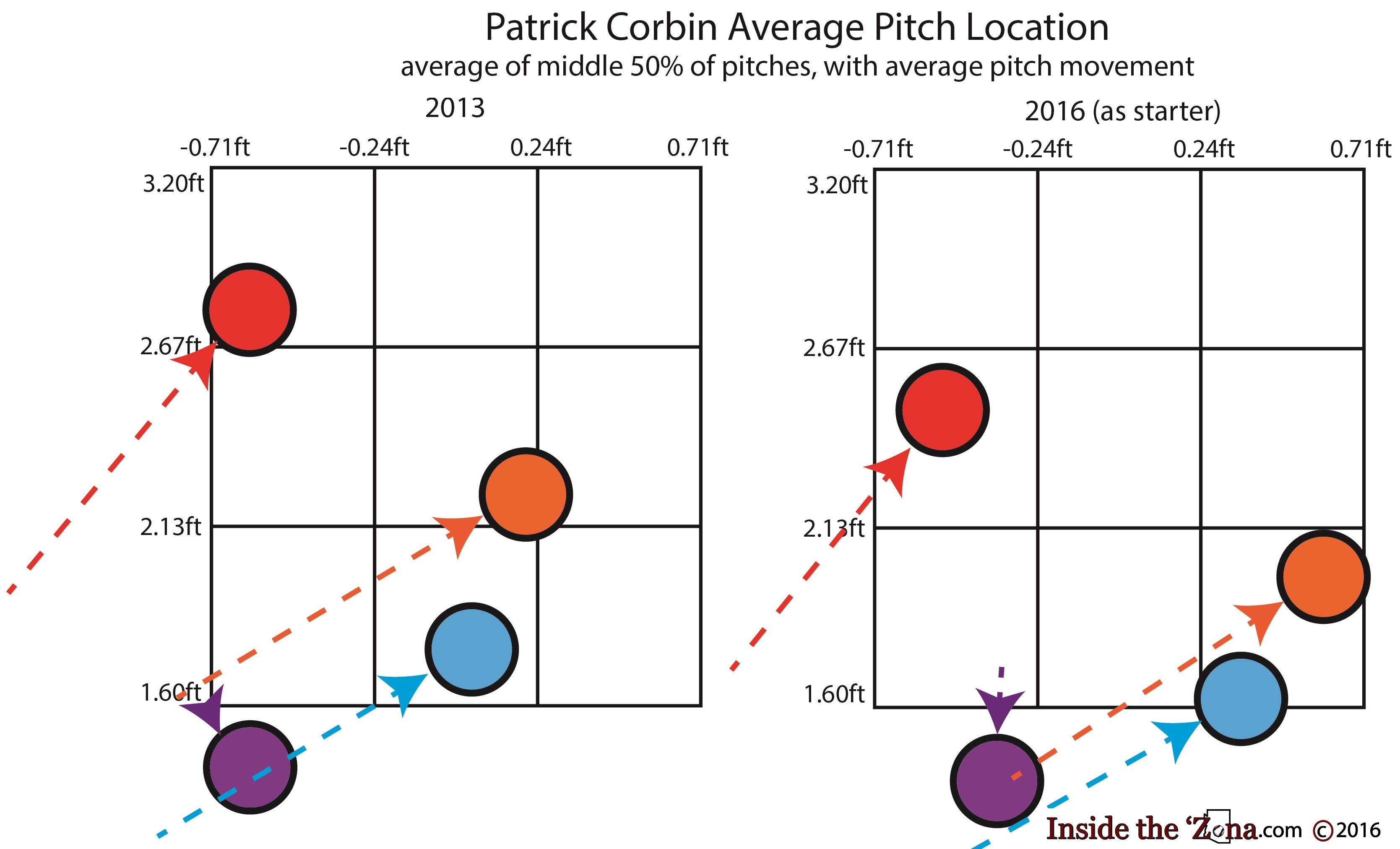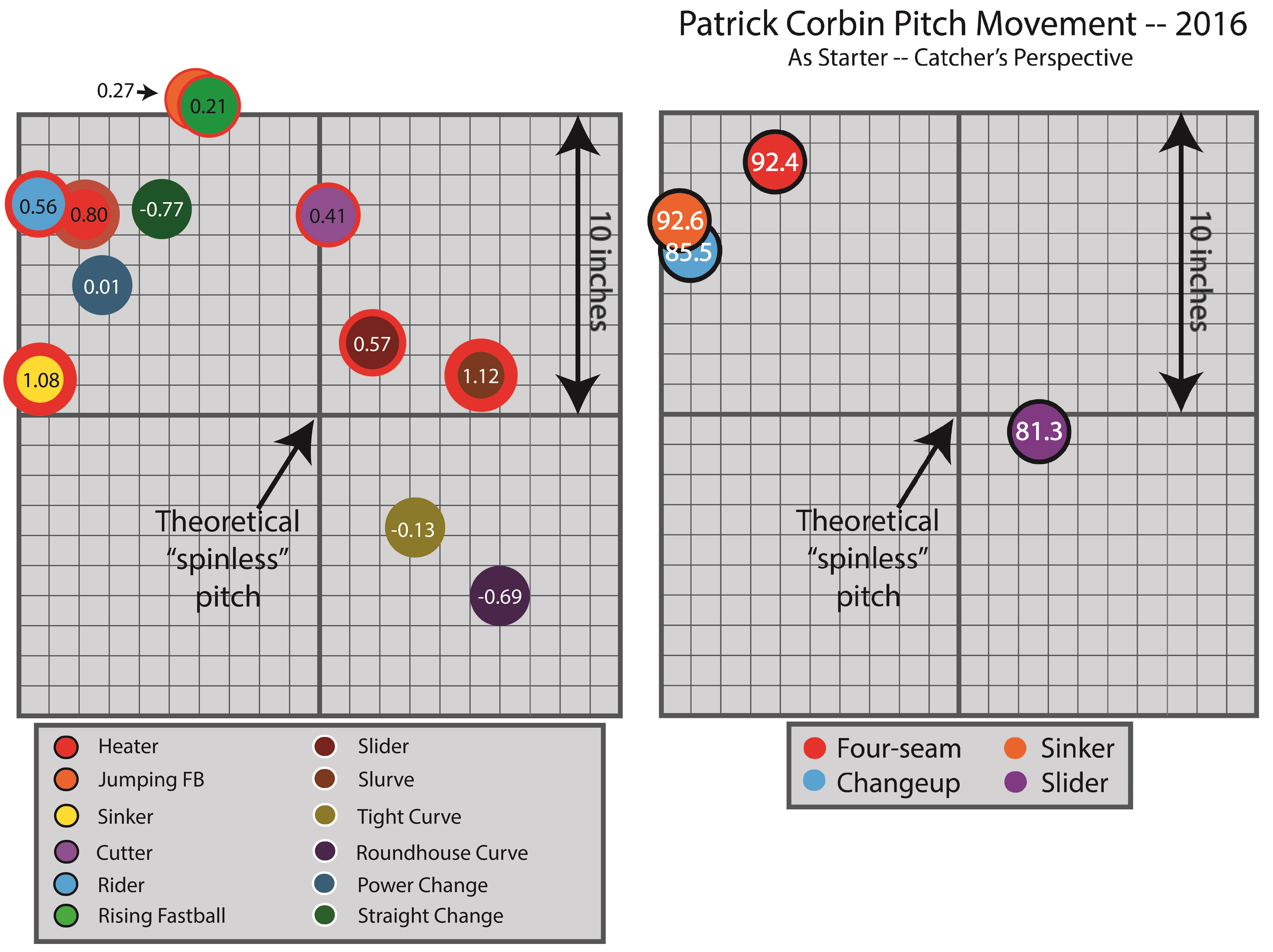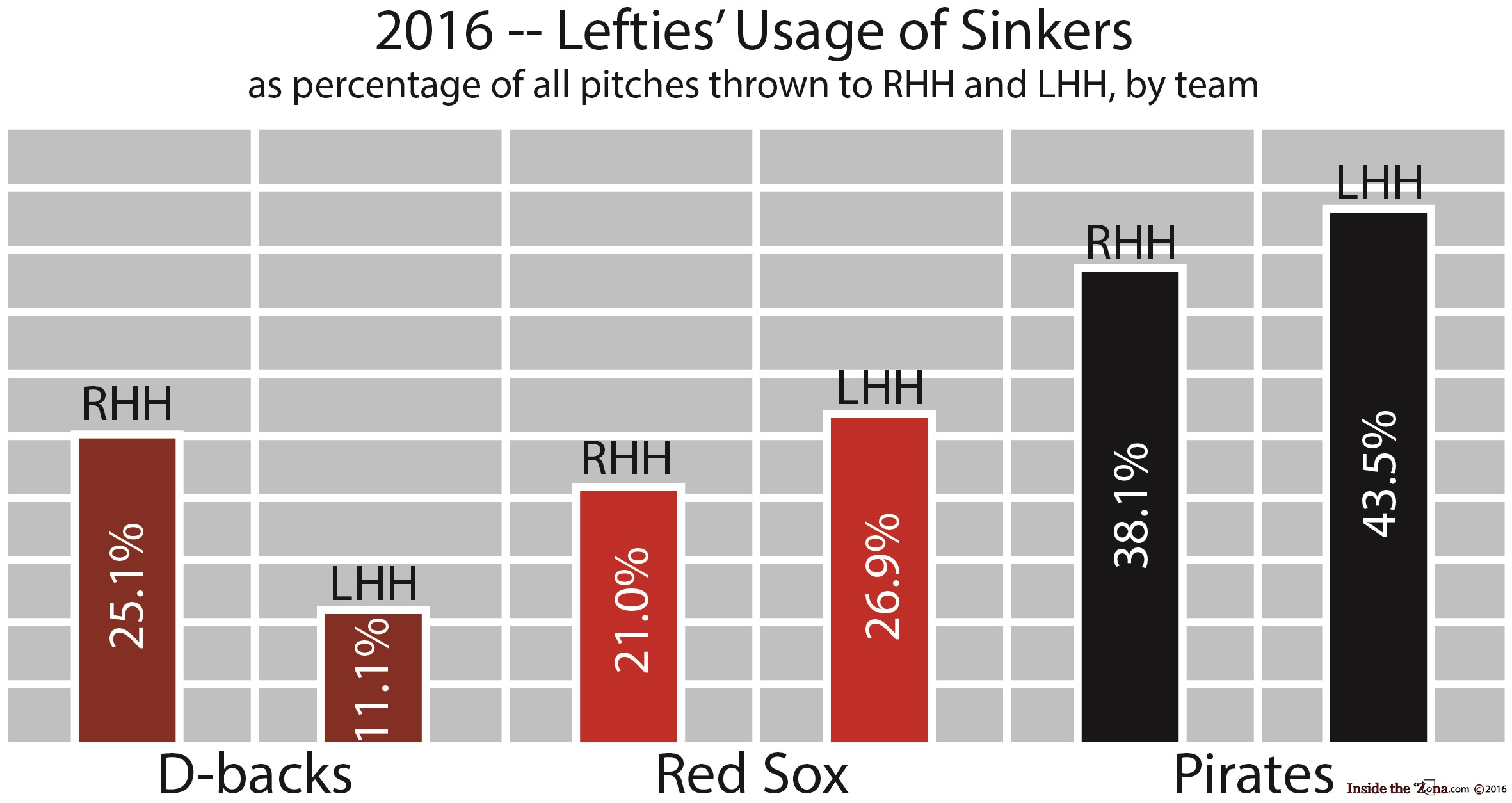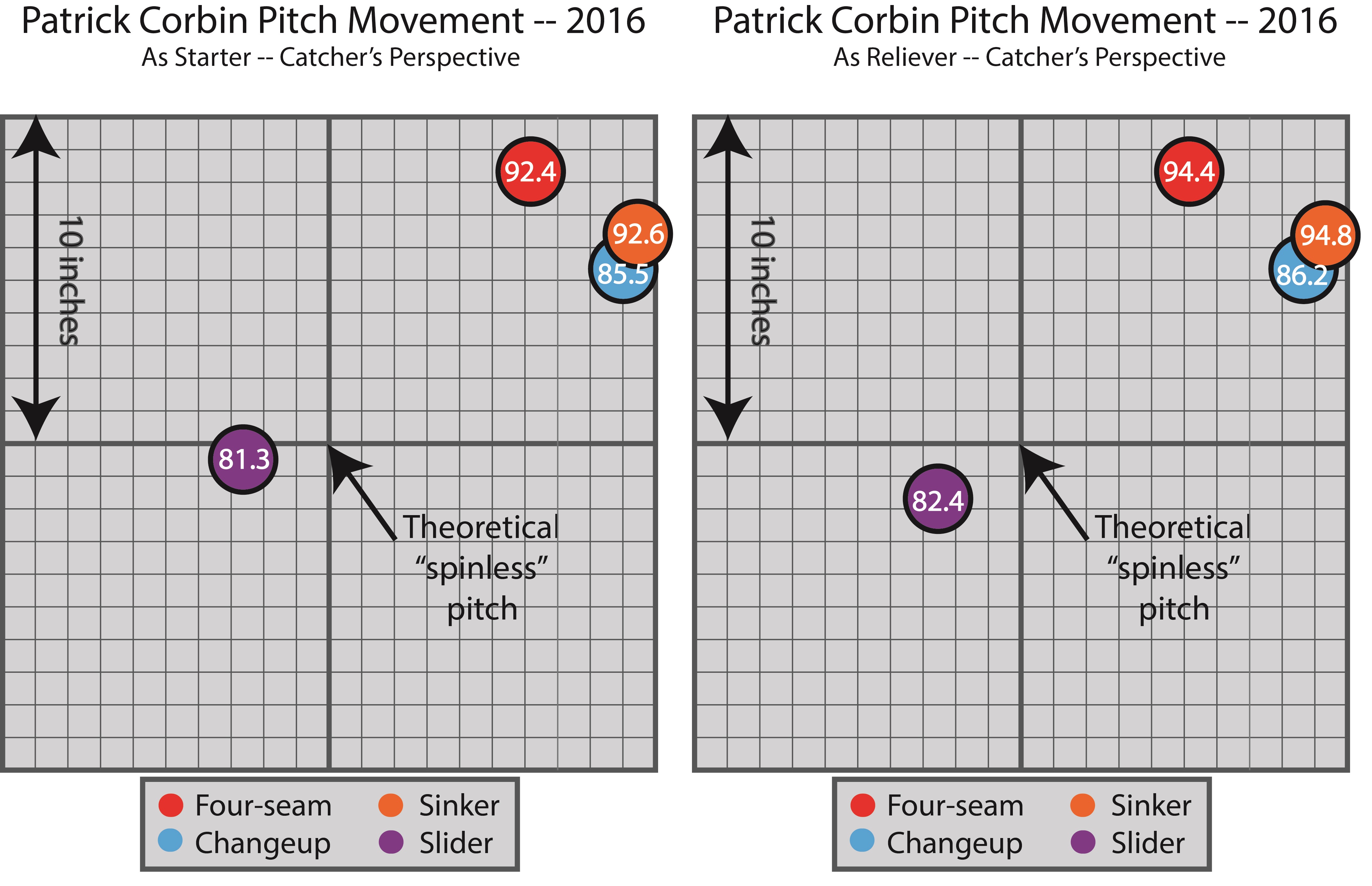Several Reasons to Believe Patrick Corbin Can and Will Be Much Better in 2017
The D-backs have several starting pitchers who fell short of expectations in 2016, and while Shelby Miller most likely headlines that list, Patrick Corbin was arguably the bigger disappointment. Before yielding 32 ER in his final 36 innings in 2013, Corbin was that ultra-rare thing: a pitcher who outperformed expectations in a D-backs uni. Since returning from UCL reconstruction in 2015, we’ve seen a different pitcher.
You can’t guarantee execution, and you usually can’t get a pitcher throwing better “stuff.” You can change his approach to at bats, though, and pitch selection is a matter of choice. Since returning in 2015 and especially in 2016, Corbin has been asked to use an outstanding array of pitches in a number of self-defeating ways. The new D-backs regime is too smart for that, and a big change in approach is coming — most likely, with better results.
Corbin Can Pitch to His Strengths Against Righties
There’s no reason to think that Corbin’s outlier 2013 says more about his likely 2017 performance than these last two seasons, but there is reason to think that Corbin can be better than what we’ve seen more recently, and 2013 has a lot to do with that. It’s hard to project better “stuff” for a pitcher, and nearly as hard to project better control, but a change in approach is a choice. By instinct, trial and error or some other facet of the minor league crucible, Corbin’s 2013 approach was an excellent fit to his stuff. We have a template for Corbin success.
Let’s look first at how his approach differed against right-handed hitters. In 2013, Corbin used his fourseam fastball up and in to righties, his slider at their feet, his change at the bottom of the zone, and his sinker down and away. When he pitched on the plate, it was largely with his sinker. That was the pitch he used to get strikes; although he threw them nearly half the time to righties and did so to get his first strike at almost the same frequency, he went to his other pitches in one ball counts, and threw sinkers over 60% of the time in three ball counts. Averaging over 10 inches of vertical movement, his sinker had to look like it was coming in the middle of the zone before sliding away into that darkest corner of the plate.
To get an idea of where Corbin threw his pitches most often, I pulled his pitches in 2013 and 2016 (as a starter only) from PITCHf/x, and averaged the pitches that were in the middle 50% in terms of location both horizontally and vertically. Here’s what that looks like (fourseam red, sinker orange, changeup blue, slider purple).

2013 is on the left, 2016 on the right. This is an imperfect way to look at location for Corbin’s pitches, but as a decent idea of where Corbin threw his pitches on purpose in each year, we could do a lot worse. We can also get an inkling about one thing that doesn’t look very good. Against a same-handed hitter, a pitcher wants to feature pitches with horizontal movement, and probably also to work both sides of the plate — that puts the pitch in the path of the barrel of the bat for a fraction less time. When a lefty like Corbin faces a right-handed hitter, though, the name of the game is forcing the hitter to make vertical adjustments. Corbin’s sinker has tremendous horizontal movement. Picture a right-handed hitter at the box, up on the left side of each of these strike zones. An average hitter’s hands might sit around that line marking the top third of the zone. In 2013, the bat needed to be flat to get that most-often-thrown-to-spot, or maybe tipped upward a bit. In 2016, not so much, or at least, not so often.
In combination with the sinker location, then, facing Corbin’s fourseam in 2016 was a function of bringing the bat head in or out — you could swing on much the same plane, between the fourseam and sinker. Add in the fact that the slider started more toward the middle of the plate in 2016. Add that by asking Corbin to get more ground outs, there was less room at the bottom of the zone to work with — Corbin’s sinker and change come in at different speeds, but have very similar movement, and then location became more similar last year. In a vacuum, I’m picking the 2013 set of locations 10 out of 10 times for a lefty facing a righty, and that’s without even looking at results.
Corbin isn’t a ground ball pitcher. What made him a borderline ace was challenging every hitter — good luck adjusting to that frisbee sinker when you might get a fourseam up on the hands, and good luck making contact with that slider, even if you know it’s coming. Against right-handed hitters, his more usual location for each pitch may have made better use of the movement of his pitches, too. Here is the same pitch plot as above, but with arrows showing the average movement of each pitch, in 2013 (on the left) and in 2016 (on the right — as a starter only).

Make of that what you will, but it looks like in 2013, the slider and sinker may have played off each other better. Also, the 2013 fourseam and slider both look terrifying, no? But both could end up called for strikes.
It does look like Corbin made more use of the corner low and away versus righties in 2016, and that’s generally a good place to limit damage. Also, we know that the D-backs preached ground balls, and we know that featuring his changeup more against righties was part of an effort to rely on his slider less, and pitch to (not particularly harmful) contact more. It didn’t really work out that way.

You can blame these differences on different pitch usage, location, less advantageous interplay between pitches, or a variety of other things. Note, though, that despite that ground ball strategy, Corbin actually did throw his sinker a lot less against righties last year, and that’s generally a good thing for a pitcher left to right, or right to left. Slugging marks in the low .400s are great for fastballs, believe it or not, but mid .500s… not so much. And while by the middle of August the changeup was a less featured part of Corbin’s arsenal, righties did a ton of damage against it early in the season.
I think the biggest difference overall was probably location, because the movement of Corbin’s pitches didn’t change all that much. Look how high the Foul% is for Corbin in 2013 on his fourseam, with a whiff rate that also beat his 2016 results. That’s consistent with an advantage in location; batters were getting the wrong part of the bat on the pitch, less so in 2016. The same is true for the sinker, to a lesser extent — although it should still be a surprise that the sinker fared better in that regard in 2013, considering how often he threw it. Meanwhile, relying more on movement to get pitches away from righties’ shoes very well may have been an advantage to Corbin with that slider. In 2013, hitters swung more often (maybe a function of being in more 2-strike counts), missed completely much more often, and also hit the ball with wrong part of the bat more often.
We’ve isolated some reasons to think that Corbin’s 2013 approach against righties made more sense, that it should have worked better. That’s no guarantee that a return to that 2013 formula will bring a return to 2013 form, but it’s a bet we can have some confidence in. As explored previously, while changeups tend to be good weapons for pitchers against opposite-handed hitters, the fact that Corbin’s has mostly horizontal movement makes it more like changeups with bad platoon splits than good splits, and Corbin probably shouldn’t rely on his change against righties. A return to a high-and-tight fourseam could also work well, while asking him to go for that low and away hole with his sinker and change may not make sense. If all of that works somewhat better, Corbin’s slider gets all the more monstrous again, and he can go back to throwing it low and in more frequently.
Corbin’s Approach Against Lefties Will Be Remade
It wasn’t all about righties in 2015 and 2016, of course — the D-backs also tinkered with Corbin’s pitch mix against lefties. The horrific results are almost self-explanatory. While location of all of Corbin’s pitches seems to help explain his sinker success against righties, we know from the Max Marchi platoon split numbers (find a full explanation here) that some types of pitches have dramatically different platoon splits, and some large trends jump out after pitches are clustered in a more granular way, as Marchi did. Some pitchers’ sinkers have movement similar to other pitchers’ fourseam fastballs — and there are lots fastballs. As noted above, the most horizontal pitches tend to have much larger platoon splits, and that works both ways. Corbin’s sinker should be excellent against lefties, the way Justin Masterson‘s sinker once eat right-handed hitters alive. And while his changeup isn’t of the type that right-handed pitchers have found particularly effective against left-handed hitters, that also means Corbin’s change is of the type that could be really effective against same-handed hitters, lefties in his case.
Compare the Marchi platoon splits (in Run Value per 100 pitches) to Corbin’s arsenal:

Head back here for more on the Marchi splits, but Corbin’s sinker is somewhere in between “Heater” (96.1 avg mph) and “Rider” (89.8 mph). His fourseam doesn’t fit cleanly in any category, but halfway between “Jumping FB” (92.8 mph) and “Heater” (96.1 mph). The two Marchi changeup groupings are “Power Change” (84.3 mph) and “Straight Change” (79.5 mph), and Corbin’s slider is really its own breed — not as horizontal as the “Slider” or “Slurve,” but much more similar to those than the curveball groupings (although at 81.2 mph, the “Tight Curve” could still be instructive).
I tend to think the Marchi platoon splits betray two general principles. One: the faster the pitch, the bigger the platoon split, generally. The second is what I referred to earlier, that the more horizontal a pitch’s movement, the larger the platoon split. You shouldn’t have to squint, but when judging a pitch to be “horizontal” or “vertical,” it probably helps to compare the pitch not to the theoretical spinless pitch, but to an “average” pitch, something like two or three inches to the left of center and two or three inches up from center.
I flipped Corbin’s pitches from left to right for ease of comparison to the Marchi numbers only, but note that it’s a bit of a leap to assume the RHP groupings that Marchi found would be similar for lefties. I’d like to take it on faith that they do, if only because I’ve found it to be a fairly reliable guide in some research to date. I also think that even if the groupings are different for lefties, those two principles might survive. They may be as simple as geometry, and swing path.
If we were to guess from the Marchi numbers, then, we might guess that Corbin’s fourseam would have a platoon split in the 0.40 Run Value per 100 range — a real phenomenon, but not enough to try to avoid using the pitch at most costs. His sinker is really smack dab between the “Rider” and “Heater” fastballs in terms of velocity (note: Marchi velocities were PITCHf/x, so reduce Corbin’s “Release Speeds” a bit), but fits “Rider” on horizontal movement — I’d guess a 0.75 Run Value per 100, or close to it. Corbin’s change is nowhere near “Straight Change,” and given that it’s much more horizontal than “Power Change” while also coming in hotter, you’d have to guess something like 0.40 Run Value per 100 on the pitch, although I admit I’m pretty far off book. It’s not as fast as the 0.56 RV/100 “Rider,” but it’s also more vertical. Slider? Your guess is as good as mine, but if you were to split the difference between “Slider” and “Tight Curve,” you’d get a RV/100 in the 0.30 range.
Platoon splits aren’t necessarily bad. One of the biggest reasons that velocity seems to be a general principle is not so much that opposite-handed hitters feast on those pitches — it’s probably even more about how damned effective they can be against same-handed hitters. Corbin’s slider and change and fourseam should be a little better against lefties, in keeping with the regular overall platoon advantage he’d be expected to enjoy. That sinker, though — that should be a real knockout pitch against lefties, based on movement. For most pitchers, sinkers and sliders and changeups like Corbin’s are great weapons against same-handed hitters. Corbin has a great anti-lefty arsenal, but we haven’t really seen that harnessed, and we saw it scattered along the countryside in 2016.
In 2013, Corbin threw his sinker 27.54% of the time against lefties — they were hilariously bad at hitting them, too. Left-handed batters fouled off sinkers almost 24% of the time, whiffed almost 8% of the time… and beat the ball into the ground, to the tune of a 69% ground ball rate (that’s Ziegler territory). There were 51 lefty hitters who finished an at bat against the sinker, but they managed just 19 bases (a .373 SLG). Against lefties, Corbin pitched down and in with the sinker, coming in off the plate not infrequently. Corbin’s fourseam was also a big time weapon in 2013 against lefties, in part because he didn’t need to pitch on the plate — he let his arm-side movement on the pitch win him some called and swinging strikes low and away, back dooring the pitch over the plate. The slider may have played particularly nice with the fourseam, as Corbin also threw the slider down and away a ton — 99 of those sliders were both below the zone and outside the zone, down and away, with just 80 sliders within the rulebook strike zone.

From a potentially-underutilized 27.54% usage in 2013, Corbin’s sinker took the back seat against lefties in 2016 in favor of the fourseam… with disastrous results. His slider was his best pitch against lefties in 2013, but either because of exposure or because hitters could adjust while sitting fourseam, Corbin’s slider did little damage against lefties in 2016. This seems like a pretty simply adjustment to me, and I see no reason why the 2013 approach in terms of location can’t work again in 2017. One thing’s for sure, though — we’ll see more sinkers. Mike Hazen’s Red Sox and Mike Fitzgerald‘s Pirates had their lefties throw sinkers significantly more often to lefties in 2016 — not dramatically less often, as did the D-backs.

Worst Case, Corbin Could Be a Knockout Reliever
Corbin’s stuff actually was better at the end of last season; after switching into a relief role in late August (in part because of a very real risk of increasing his innings output too much, too fast), Corbin saw his velocity tick up on all four of his pitches, and instead of losing movement on his pitches, his fastballs remained steady and his slider added more break. In his final 15 innings of the season, he struck out one third of the batters he faced.

For reasons stated above and others, Corbin should get tried in the rotation again, with some rope to try some appropriate, new approaches to at bats. Chances are he won’t duplicate these relief gains when starting, but you can’t necessarily rule out some uptick. That’s an additional reason to try him in the rotation, really, because by and large, 1 mph of fastball velocity translates to about 0.40 points of ERA.
Still, the fact that Corbin’s stuff did play up in relief is significant in its own right. Not every pitcher has stuff that actually plays up, and if Corbin can duplicate this in relief again, perhaps in a relief role later into the season if things don’t work out, his floor is still very high. No, he’s not necessarily Andrew Miller — but there are actually several similarities. Miller stalled out as a starting pitcher despite his prospect pedigree, but slowly began to thrive once put in a relief role with the Red Sox — in part because he shelved his change and relied more and more on his slider, which was good enough to whiff lefties and righties alike. That’s not a lesson that Mike Hazen is likely to forget. Like Miller, Corbin has thrown 92-93 as a starter, but 94-95 as a reliever. Like Miller, Corbin has a slider that is one of the best in the game. Like Miller, Corbin probably has no business bothering with changeups. The main difference between Corbin and Miller may be that we know Corbin’s sinker can be an effective pitch against right-handed hitters, defying the odds. If Corbin is a tick below Miller in the control department, a third usable pitch might make up the difference.
Overall, though, there are quite a few reasons to think that Corbin can be much improved in 2017, and that his 2013 performance isn’t even his ceiling, necessarily. Few pitchers have ever thrived at Chase for months at a time, but Corbin’s big-bending slider is the kind of pitch that works even at Coors. Corbin is about as good a rotation option as the D-backs could get their hands on inside or outside the organization, more than justifying a rotation spot. Don’t bet against him.
6 Responses to Several Reasons to Believe Patrick Corbin Can and Will Be Much Better in 2017
Leave a Reply Cancel reply
Recent Posts
@ryanpmorrison
 Congrats to @OutfieldGrass24 on a beautiful life, wedding and wife. He deserves all of it (they both do). And I cou… https://t.co/JzJtQ7TgdJ, Jul 23
Congrats to @OutfieldGrass24 on a beautiful life, wedding and wife. He deserves all of it (they both do). And I cou… https://t.co/JzJtQ7TgdJ, Jul 23 Best part of Peralta’s 108 mph fliner over the fence, IMHO: that he got that much leverage despite scooping it out… https://t.co/ivBrl76adF, Apr 08
Best part of Peralta’s 108 mph fliner over the fence, IMHO: that he got that much leverage despite scooping it out… https://t.co/ivBrl76adF, Apr 08 RT @OutfieldGrass24: If you're bored of watching Patrick Corbin get dudes out, you can check out my latest for @TheAthleticAZ. https://t.co/k1DymgY7zO, Apr 04
RT @OutfieldGrass24: If you're bored of watching Patrick Corbin get dudes out, you can check out my latest for @TheAthleticAZ. https://t.co/k1DymgY7zO, Apr 04 Of course, they may have overtaken the league lead for outs on the bases just now, also...
But in 2017, Arizona ha… https://t.co/38MBrr2D4b, Apr 04
Of course, they may have overtaken the league lead for outs on the bases just now, also...
But in 2017, Arizona ha… https://t.co/38MBrr2D4b, Apr 04 Prior to the games today, there had only been 5 steals of 3rd this season (and no CS) in the National League. The… https://t.co/gVVL84vPQ5, Apr 04
Prior to the games today, there had only been 5 steals of 3rd this season (and no CS) in the National League. The… https://t.co/gVVL84vPQ5, Apr 04
Powered by: Web Designers@outfieldgrass24
 RT @ZHBuchanan: If you haven't filled out our Diamondbacks fan survey yet, there's still time. We want to hear from you!
https://t.co/ctzkNTbk5s, Jan 13
RT @ZHBuchanan: If you haven't filled out our Diamondbacks fan survey yet, there's still time. We want to hear from you!
https://t.co/ctzkNTbk5s, Jan 13 “Top US News: Tesla merch now available for purchase with Dogecoin”
The point at which I wish to formally withdraw… https://t.co/7k38A7nDCQ, Jan 14
“Top US News: Tesla merch now available for purchase with Dogecoin”
The point at which I wish to formally withdraw… https://t.co/7k38A7nDCQ, Jan 14 Ya boi with the feature image https://t.co/g3SMJYmAQq, Jan 14
Ya boi with the feature image https://t.co/g3SMJYmAQq, Jan 14 Nelson fell asleep waiting for Simcoe to get home from the groomer. I’m jealous, honestly. https://t.co/CO4FZtwhUJ, Jan 13
Nelson fell asleep waiting for Simcoe to get home from the groomer. I’m jealous, honestly. https://t.co/CO4FZtwhUJ, Jan 13 RT @OutfieldGrass24: Dynasty question: Daniel Espino, Emerson Hancock, and Quinn Priester. Gotta cut one. Who should it be?, Jan 13
RT @OutfieldGrass24: Dynasty question: Daniel Espino, Emerson Hancock, and Quinn Priester. Gotta cut one. Who should it be?, Jan 13
Powered by: Web Designers





The biggest difference between Corbin and Miller is attitude. All the statistics and analytics in the world won’t make a difference until Corbin toughens up mentally.
lol
Make the dbacks gritty again!
Cause we all know mental strength has everything to do with changing pitching approaches.
After Fernando Rodney shows us his best Heath Bell imitation, maybe they will try Patrick at closer. It just might work.
[…] as a multi-inning reliever from the left side to help balance the bullpen and provide some length. There are reasons for optimism, but the direction remains unclear. It appears that Corbin’s preference is to get back to the […]